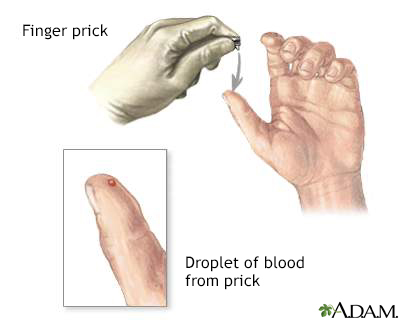Capillary sample
Definition
A capillary sample is a blood sample collected by pricking the skin. Capillaries are tiny blood vessels near the surface of the skin.
Alternative Names
Blood sample - capillary; Fingerstick; Heelstick
How the Test is Performed
The test is done in the following way:
- The area is cleansed with antiseptic.
- The skin of the finger, heel, or another area is pricked with a sharp needle or a lancet.
- The blood may be collected in a pipette (small glass tube), on a slide, onto a test strip, or into a small container.
- Cotton or a bandage may be applied to the puncture site if there is any continued bleeding.
How the Test will Feel
Some people feel moderate pain. Others feel only a prick or stinging sensation. Afterward, there may be some throbbing.
Why the Test is Performed
Blood transports oxygen, food, waste products, and other materials within the body. It also helps regulate body temperature. Blood is made up of cells and a fluid called plasma. Plasma contains various dissolved substances. The cells are mainly red blood cells, white blood cells, and platelets.
Because blood has many functions, tests on the blood or its components provide valuable clues in the diagnosis of medical conditions.
Capillary blood sampling has several advantages over drawing blood from a vein:
- It is easy to obtain (it can be difficult to obtain blood from the veins, especially in infants).
- There are several collection sites on the body, and these sites can be rotated.
- Testing can be done at home and with little training. For example, persons with diabetes must check their blood sugar several times a day using capillary blood sampling.
Disadvantages to capillary blood sampling include:
- Only a limited amount of blood can be drawn using this method.
- The procedure has some risks (see below).
- Capillary blood sampling may result in inaccurate results, such as falsely elevated sugar, electrolyte, and blood count values.
What Abnormal Results Mean
Results vary depending on the test done. Your health care provider can tell you more.
Risks
Risks of this test may include any of the following:
- Excessive bleeding
- Fainting or feeling lightheaded
- Infection (a slight risk any time the skin is broken)
- Scarring (occurs when there have been multiple punctures in the same area)
- Calcified nodules (sometimes occurs in infants, but usually disappear by 30 months of age)
- Damage to blood cells from this method of collection can sometimes cause inaccurate test results and the need to repeat the test with blood drawn from a vein
Gallery



References
Garza D, Becan-McBride K. Capillary of dermal blood specimens. In: Garza D, Becan-McBride K, eds. Phlebotomy Handbook. 10th ed. Upper Saddle River, NJ: Pearson; 2018:chap 11.
Vajpayee N, Graham SS, Bem S. Basic examination of blood and bone marrow. In: McPherson RA, Pincus MR, eds. Henry's Clinical Diagnosis and Management by Laboratory Methods. 24th ed. Philadelphia, PA: Elsevier; 2022:chap 31.